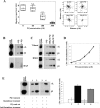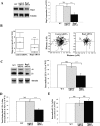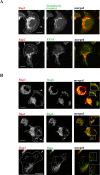A role for Rap2 in recycling the extended conformation of LFA-1 during T cell migration
- PMID: 23213397
- PMCID: PMC3507183
- DOI: 10.1242/bio.20122824
A role for Rap2 in recycling the extended conformation of LFA-1 during T cell migration
Abstract
T lymphocytes make use of their major integrin LFA-1 to migrate on surfaces that express ICAM-1 such as blood vessels and inflamed tissue sites. How the adhesions are turned over in order to supply traction for this migration has not been extensively investigated. By following the fate of biotinylated membrane LFA-1 on T lymphocytes, we show in this study that LFA-1 internalization and re-exposure on the plasma membrane are linked to migration. Previously we demonstrated the GTPase Rap2 to be a regulator of LFA-1-mediated migration. SiRNA knockdown of this GTPase inhibits both LFA-1 internalization and also its ability to be re-exposed, indicating that Rap2 participates in recycling of LFA-1 and influences its complete endocytosis-exocytosis cycle. Confocal microscopy images reveal that the intracellular distribution of Rap2 overlaps with endosomal recycling vesicles. Although the homologous GTPase Rap1 is also found on intracellular vesicles and associated with LFA-1 activation, these two homologous GTPases do not co-localize. Little is known about the conformation of the LFA-1 that is recycled. We show that the extended form of LFA-1 is internalized and in Rap2 siRNA-treated T lymphocytes the trafficking of this LFA-1 conformation is disrupted resulting in its intracellular accumulation. Thus LFA-1-mediated migration of T lymphocytes requires Rap2-expressing vesicles to recycle the extended form of LFA-1 that we have previously found to control migration at the leading edge.
Keywords: Integrin; LFA-1; Migration; Rap2; Recycling.
Conflict of interest statement
Figures




Similar articles
-
The Gαq/11 proteins contribute to T lymphocyte migration by promoting turnover of integrin LFA-1 through recycling.PLoS One. 2012;7(6):e38517. doi: 10.1371/journal.pone.0038517. Epub 2012 Jun 11. PLoS One. 2012. PMID: 22701657 Free PMC article.
-
RhoB controls the Rab11-mediated recycling and surface reappearance of LFA-1 in migrating T lymphocytes.Sci Signal. 2017 Dec 12;10(509):eaai8629. doi: 10.1126/scisignal.aai8629. Sci Signal. 2017. PMID: 29233918
-
Characterization of interactions of adapter protein RAPL/Nore1B with RAP GTPases and their role in T cell migration.J Biol Chem. 2007 Oct 19;282(42):30629-42. doi: 10.1074/jbc.M704361200. Epub 2007 Aug 23. J Biol Chem. 2007. PMID: 17716979
-
The role of the integrin LFA-1 in T-lymphocyte migration.Immunol Rev. 2007 Aug;218:135-46. doi: 10.1111/j.1600-065X.2007.00537.x. Immunol Rev. 2007. PMID: 17624950 Review.
-
Not all (cells) who wander are lost: Upstream migration as a pervasive mode of amoeboid cell motility.Front Cell Dev Biol. 2023 Nov 2;11:1291201. doi: 10.3389/fcell.2023.1291201. eCollection 2023. Front Cell Dev Biol. 2023. PMID: 38020916 Free PMC article. Review.
Cited by
-
LFA-1 in T Cell Migration and Differentiation.Front Immunol. 2018 May 3;9:952. doi: 10.3389/fimmu.2018.00952. eCollection 2018. Front Immunol. 2018. PMID: 29774029 Free PMC article. Review.
-
SNX17 affects T cell activation by regulating TCR and integrin recycling.J Immunol. 2015 May 1;194(9):4555-66. doi: 10.4049/jimmunol.1402734. Epub 2015 Mar 30. J Immunol. 2015. PMID: 25825439 Free PMC article.
-
Ras-related protein Rap2c promotes the migration and invasion of human osteosarcoma cells.Oncol Lett. 2018 Apr;15(4):5352-5358. doi: 10.3892/ol.2018.7987. Epub 2018 Feb 7. Oncol Lett. 2018. PMID: 29552178 Free PMC article.
-
The role of small GTPases and EPAC-Rap signaling in the regulation of the blood-brain and blood-retinal barriers.Tissue Barriers. 2017 Jul 3;5(3):e1339768. doi: 10.1080/21688370.2017.1339768. Epub 2017 Jun 9. Tissue Barriers. 2017. PMID: 28632993 Free PMC article. Review.
-
Amoeboid Swimming Is Propelled by Molecular Paddling in Lymphocytes.Biophys J. 2020 Sep 15;119(6):1157-1177. doi: 10.1016/j.bpj.2020.07.033. Epub 2020 Aug 12. Biophys J. 2020. PMID: 32882187 Free PMC article.
References
Grants and funding
LinkOut - more resources
Full Text Sources
Miscellaneous

